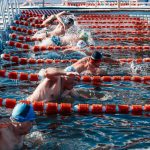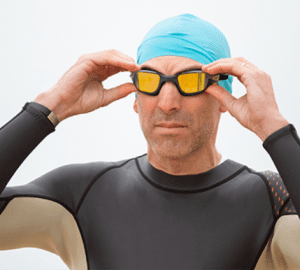Learning feel for the water
Follow Terry Laughlin’s self-sensing and technique-based focal points to improve your sensory awareness
Elite athletes appear different – physically – from the rest of us; they seem to have been ‘born to greatness.’ For instance, the world’s best freestylers are much taller than average, with supple joints, broad shoulders and narrow hips. Their bodies seem designed to maximise power, minimise drag and produce naturally superior stroke length. They also receive the best coaching and have time to train many more hours per week, to build upon those physical advantages.
But elites also share a less obvious advantage over average athletes: studies have shown they possess far greater kinesthetic, or sensory, awareness. And while elites in all sports have superior self-sensing ability, it rises to its highest level in swimming. This is because swimmers are immersed in a sensory-rich environment, in which every square millimetre of skin receives feedback from the water. We literally swim in a ‘sea of information’ which offers potentially invaluable guidance on how to increase efficiency. Coaches call this ‘feel for the water’ and speak of it as a little-understood quality that some athletes just have from birth and others… well, those unfortunates just lack it.
However, in teaching late-starting adults for over 25 years, I’ve seen countless times that feel for the water is learnable. You cultivate it by doing something that comes naturally to very few swimmers – and is not an explicit part of any traditional training programme. I’m referring to training in which self-sensing is a formal, systematic and indeed foundational element, given equal or greater importance as aspects like distance, time and effort.
You cultivate it by doing something that comes naturally to very few swimmers: placing primary emphasis on the formal and systematic training of one’s ‘self-sensing’ abilities. This meta-cognitive approach has thousands of years of history in movement or martial arts like T’ai Chi and Qi Gong, but is entirely new to the way most people think about swimming practice.
The development of a high level of self-sensing ability is the first element in the Mind-Body training approach taught by Total Immersion. Its most immediate benefit is that – unlike physical characteristics such as size, body type or fitness – average swimmers can equal or surpass elites in feel for the water by including self-sensing elements as a core part of their training programme. A more holistic benefit is that it produces many of the salutary effects of mindfulness training (which is based on self-sensing of the breath, posture, mind-focus, etc) and transforms tedious and repetitive training into an engaging and enjoyable activity.
Three steps to greater awareness
Introduce self-sensing elements and tasks to your training via a three-step process:
Pay attention. Create an organised and prioritised way to scrutinise specific aspects of your stroke. While swimming laps or participating in squad training, it’s likely everyone around you will be focused mainly on getting to the other end of the pool, ‘getting through’ the set… or musing idly on what they’ll do when the workout ends. In contrast, you will choose a specific focal point– eg, head-spine alignment, how the water resists various body surfaces or the noise produced by your stroke – then focus on it intensely and tirelessly. At first, you’ll discover this is quite challenging. But, like maintaining focus in meditation, your ability to concentrate improves with practice. You’ll also find that it makes any lap, practice – or race – more enjoyable.
Notice and compare. When ‘targeted’ attention becomes a habit, you’ll begin to notice subtle sensations you’ve always overlooked. This feedback can be invaluable to improving elements of stroke efficiency like drag and stroke-integration. Once you create formal feedback loops, begin to assess what this feedback means and how to respond. Do you swim faster with more ease, or fewer strokes? Does one focus make your stroke feel better overall than another.
Make informed choices. Use this new information to make more effective choices. This transforms formerly generic or ‘one-size-fits-all’ training into a personalised problem-solving exercise. This adds a sense of purpose to the engagement and enjoyment produced by the mindfulness part of self-sensing training.
Three ways to organise self-sensing training
Like any form of training, you’ll get the best results from this training by doing it in a systematic way. Here are three ways of organising. With practice, you can employ all three in a single set, but I suggest you to start more simply by choosing one.
By skill: In the Total Immersion hierarchy of technique skills, balance ranks highest, streamlining skills come second, integrated propulsion skills come third. If you’ve had relatively little formal technique instruction, or feel that you work too hard for too little result, the biggest payoff will come from the first two skills.
By type: There are three types of focus – internal, external and visualisation. With internal focus, you send a message from brain to body part; eg, relax all forearm muscles during recovery. In external focus, you pay attention to sensory input – what you feel, see or hear. In a visualisation, you add a familiar element to the overall picture – for instance, an imaginary towline attached to the top of your head. Combining internal and external focus is especially effective in increasing self-perception.
By body part: Total Immersion’s favourite way is a front-to-rear body scan. First check the position, orientation or direction of head or extended hand and arm, then torso, then legs.
Improve sensory awareness with this set
Warm up, then do a short ‘benchmark’ swim – from 50 to 200m at a moderate or ‘cruise’ pace. Count strokes, take time and give a ‘perceived effort’ rating – from one for effortless to five for exhausting.
Swim 4 to 8 x focal point/self-sensing lengths for each skill category described below. Your goals are to focus intently on a specific sensation in your stroke and incrementally strengthen it during the set. (I frequently close my eyes involuntarily while doing this, to heighten my sensitivity to sensory input.) After each length, assess the sensation, and your consistency of focus. Use your interval between each length as much for a mental reset, as for physical rest. To improve your outcome, continue visualising your stroke between repeats – to deepen the mental imprint of what you’re striving to feel.
Balance: Feel that your head is weightless – fully supported by a ‘cushion’ of water. Also, notice if: head and spine feel more aligned; and neck and upper back feel more relaxed.
Streamline: Focus on how you enter and extend your hand. Enter as quietly as possible, then reach a little farther than you do normally. Notice if: your hand, arm and shoulder enter with less water disturbance – especially just after each breath; and you feel a bit ‘taller’ and sleeker in the water.
Integrated Propulsion: Pay attention to the perceived speed of your hand moving back. Compare with the speed of your body moving forward. If your hand is moving noticeably faster than your body, slow or ease your stroke until the two match. Notice if your stroke feels smoother and more integrated when you sense a speed match.
Choose your favorite sensation – or try to blend two or more. Repeat the benchmark swim. Can you swim as fast with fewer strokes and/or less effort? Choose the most promising sensation and work at it until it becomes stronger and more consistent. Enjoy the sense of increased efficiency, engagement and purpose this brings.
Expert advice
Terry Laughlin is founder and head coach of Total Immersion and winner of six national masters championships since turning 55. The Total Immersion 2.0 Freestyle Mastery Self-Coaching Course teaches ‘Expert’ Pacing/Tempo Training and three other Mastery skills for freestyle.







